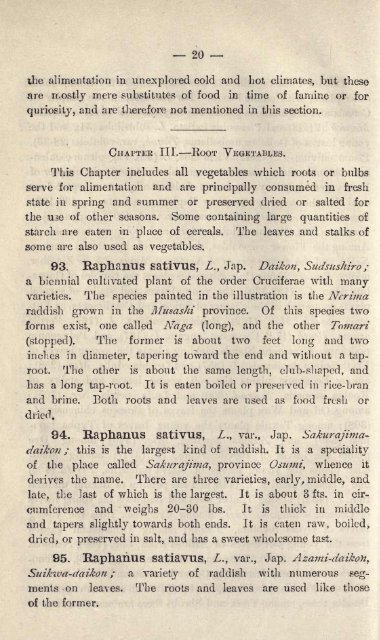Untitled - Library
Untitled - Library
Untitled - Library
Create successful ePaper yourself
Turn your PDF publications into a flip-book with our unique Google optimized e-Paper software.
20<br />
the alimentation in unexplored cold and hot climates, but these<br />
are mostly mere substitutes of food in time of famine or for<br />
quriosity, and are therefore not mentioned in this section.<br />
CHAPTER III.<br />
ROOT VEGETABLES.<br />
This Chapter includes all vegetables<br />
which roots or bulbs<br />
serve for alimentation and are principally consumed in fresh<br />
state in spring and summer or preserved<br />
dried or salted for<br />
the use of other seasons. Some containing large quantities of<br />
starch are eaten in place<br />
some are also used as vegetables.<br />
of cereals. The leaves and stalks of<br />
93. RaphanilS satiVUS, Z., Jap. Daikon, Sudsushiro ;<br />
a biennial cultivated plant of the order Cruciferae with many<br />
varieties. The species painted in the illustration is the Nerima<br />
raddish grown in the Musashi province. Of this species two<br />
forms exist, one called Naga (long), and the other Tomari<br />
(stopped). The former is about two feet long and two<br />
inches in diameter, tapering toward the end and without a taproot.<br />
The other is about the same length, club-shaped, and<br />
has a long tap-root.<br />
It is eaten boiled or preserved in rice-bran<br />
and brine. Both, roots and leaves are used as food fresh, or<br />
dried.<br />
94. Raphanus satiVUS, Z., var., Jap. Sakurajimadaikon<br />
; this is the largest kind of raddish. It is a speciality<br />
of the place called Sakuraji'ma, province Osumi, whence it<br />
derives the name. There are three varieties, early, middle, and<br />
late, the last of which is the largest. It is about 3 fts. in circumference<br />
and weighs 20-30 Ibs. It is thick in middle<br />
and tapers slightly towards both ends. It is eaten raw, boiled,.<br />
dried, or preserved in salt, and has a sweet wholesome tast.<br />
95. Raphanus satiavus, L., var., Jap. Azami-daikon,<br />
Suikwa-ctaikon ; a variety of raddish with numerous segments<br />
on leaves. The roots and leaves are used like those<br />
of the former.
















